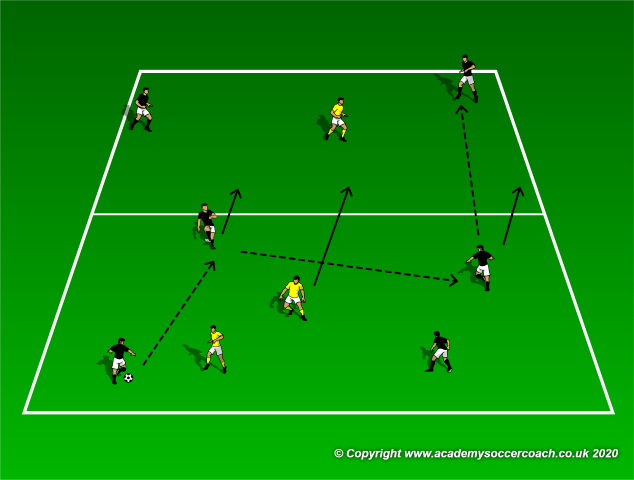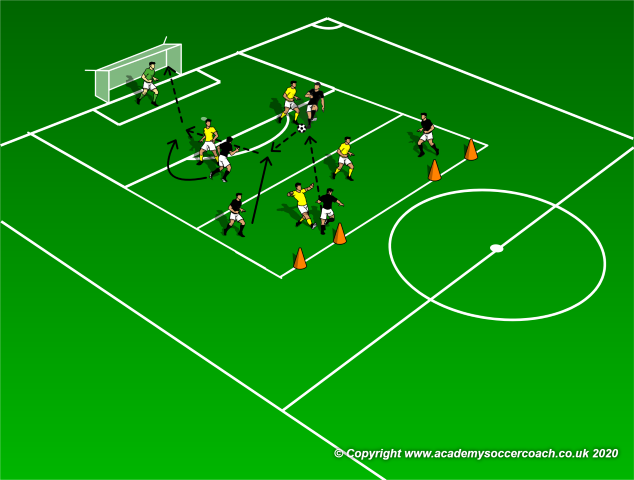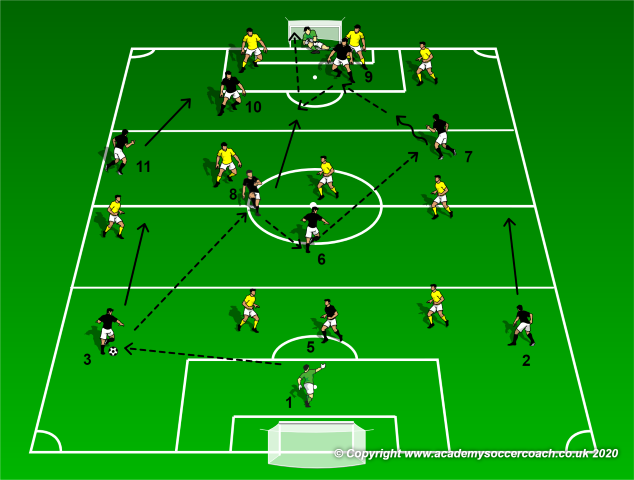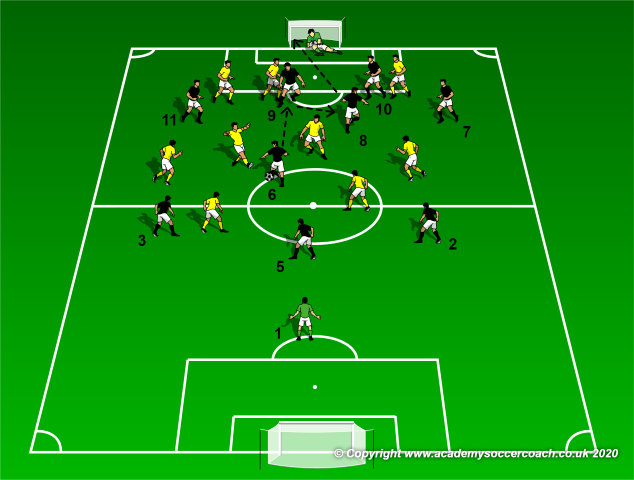By Philip Cauchi
Total duration: Approximately 90 minutes.
Moment of play: In possession.
Team task: Scoring.
Theme: Penetration from central areas.
Aim: To create goal-scoring opportunities.
Questions on which the design of the session and its relevant outcomes emerge:
Q1 – What do we try to achieve?
A1 – We try to play the ball into central areas closer to the opponents’ goal.
Q2 – Why do we want to achieve this?
A2 – To increase our chances of scoring.
Q3 – Where does it happen on the field of play?
A3 – In the attacking third.
Q4 – How are we going to penetrate the opposition’s defensive structure?
A4 – By playing quick passes to circulate the ball with the aim of opening up passing lanes from which the ball can be played vertically. We will then push one of the two midfielders forward while the two lateral midfielders move towards the middle to create a numerical overload in central areas.
Q5 – Who are the key players involved?
A5 – The striker, the attacking midfielder and the lateral midfielders.
Q6 – What if the attack fails and the opponents manage to clear the ball?
A6 – Our first objective would be to put immediate pressure on the ball to win it close to the opponents’ goal and to prevent them from launching a counter attack. If our first objective is not reached, the two lateral midfielders should be positioned outside the penalty area so to be in a position to win second balls or to counter press. At the back we will leave the central defensive midfielder covering centrally and applying the principle of preventive marking, while being covered by the two central defenders. Depending on the quality of our opponents and also the number of players they leave forward, we might push both full backs forward simultaneously or just one of them (the one on the ball-side). This would leave us with three at the back and therefore in a numerical advantage and better cover.
System of play: 1-4-4-2
Macro-principles: Penetration and support.
Sub-principles: Staggered positions of the two strikers (9 and 10), insertion of the attacking midfielder (8) into the attack, and the lateral midfielders (7 and 11) moving towards the inside.
Sub-sub-principles: Off-the-ball movement to open up passing lanes, timing of passes, timing and direction of runs.
Number of players: 18 outfield players plus 2 goalkeepers.
Warm-up
Practice 1: 4v2 to 4v2 rondo.

Aim: To follow play after playing the vertical pass.
Duration: 10 minutes.
Area: 25 yards by 15 yards which is divided into two equal horizontal zones.
Players: Four attackers in the ball zone and two attackers in the opposite zone. Two defenders in the ball zone and another one in the opposite zone.
Description: The attackers (blacks) play 4v2 against the two defenders (yellows). The attackers (blacks) must play at least three passes before passing the ball into the opposite zone. Upon passing the ball into the opposite zone, two attackers and a defender follow to make the play 4v2 in favour of the attackers again in this zone. If the defenders win the ball they aim to dribble it out of the area to score a point. This develops the behaviour in our team to immediately apply pressure on the ball as soon as it is lost in order to regain possession. The attackers score a point for every three successful switches of play.
Progression: Play 3v2 in the ball zone and 2v2 in the opposite zone. The ball may be dribbled or passed into the adjacent zone after every 10 seconds.
N.B. A 10 minute dynamic war-up should be carried out prior to this practice.
Key performance outcomes: Positioning, angles of support, stance, oriented first touch, quality of pass to the appropriate foot and timing of the pass.
Main part
Practice 2: Supporting the attack to finish on goal.

Aim: To follow play after playing the vertical pass to overload the attack.
Duration: 20 minutes (4 series of 3 minutes with 2 minutes recovery in between).
Area: 30 yards in length by 40 yards in width which is divided into two equal horizontal zones. This area is marked in front and adjacent to the penalty area. Thus, together with the penalty area they form three zones.
Players: Three attackers and two defenders in the last zone. Two attackers and two defenders in the middle zone and a goalkeeper in goal. The offside line is the edge of the penalty area.
Description: The attackers start by playing 3v2 in the last zone. They ball can be played into the middle zone with a pass or a dribble. Once the ball is in the middle zone another attacker joins the attack to make it a 3v2. The ball can then be played into the penalty area to finish on goal. If the defenders win the ball they aim to score in any of the two mini goals formed by cones (if you have mini goals instead of cones it is even better).
Progression: A defender may follow back when the ball is played into the middle zone.
Key performance outcomes: Positioning, angles of support, stance, length in attack, timing of passes and timing of runs to support the attack.
Practice 3: Attack build-up through the thirds.

Aim: For the players in every position to get to know where their position should approximately be and what their task is when the ball is played into the final third.
Duration: 20 minutes (2 series x 9 minutes with 2 minutes recovery).
Area: A regular soccer pitch divided into three equal horizontal zones (the build-up, middle and the final third).
Players: Two teams composed of a goalkeeper, a central defender and two full backs in the build-up third. In the middle third we have a lateral midfielder on each side and two central midfielders. In the final third we have two strikers.
Description: Normal game but when the ball is in the middle third, the full backs may move into this zone to create a numerical superiority. When the ball is played into the final third, the attacking midfielder (8) and the two lateral midfielders (7 and 11) move into this zone to create an overload. When the ball is lost and high pressing fails, the players must revert back to their normal positions.
Key performance outcomes: Space created in the attacking third, timing of passes or dribble, and the timing and direction of support runs.
Conclusion
Practice 4: Normal game.
Aim: For the players to identify the moment of when and how to move and support the attack.
Duration: 20 minutes (2 series x 9 minutes with 2 minutes recovery).
Area: A regular soccer pitch.
Players: Two teams aligned in a 1-3-4-2 formation. Remember we are relating our session to a 1-4-4-2 system of play with emphasis being on penetrating the final third. Therefore if we only have ten players for each team it is necessary to have the key players involved who are, the two strikers, the central midfielders and the lateral midfielders. Thus, we have to play without one of the two central defenders in order to have the other lines and sectors intact.
Description: Normal game with regular association football rules.
Key performance outcomes: Staggered movement and positions of the two strikers, the lateral midfielders to move towards the inside, the attacking midfielder to overload the attack centrally.

Cool down
Duration: 10 minutes.
Description: Light jogging followed by static stretching. Each stretch should take at least 20 seconds.
By Philip Cauchi


